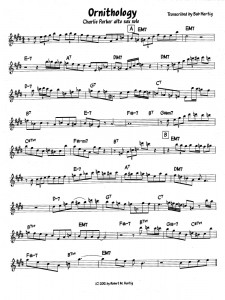 The beboppers of the 1940s and 1950s advanced the use of contrafacts,* and the godfather of bebop, alto saxophonist Charlie Parker, used them liberally. After the many tunes he wrote over the chord changes to “I Got Rhythm,” the contrafact he probably recorded most was the tune “Ornithology,” which utilizes the changes to the old standard, “How High the Moon.”
The beboppers of the 1940s and 1950s advanced the use of contrafacts,* and the godfather of bebop, alto saxophonist Charlie Parker, used them liberally. After the many tunes he wrote over the chord changes to “I Got Rhythm,” the contrafact he probably recorded most was the tune “Ornithology,” which utilizes the changes to the old standard, “How High the Moon.”
I have no idea exactly how many recordings exist of Bird holding forth on “Ornithology.” I only know that there are lots. The tune was clearly a favorite vehicle for Parker, and the transcription shown here captures his first 32 bars of an extended flight. I hope to transcribe the rest of it in time, but the process keeps getting interrupted by other priorities, so for now at least, I thought I’d share this much of Bird’s solo with you. It’s plenty ’nuff to whet your chops on.
Charlie Parker not only had a phenomenal technique, but an equally amazing melodic concept. Both are on display here. Just click on the image and enjoy soaring with Bird.
If you enjoyed this post, visit my Jazz Theory, Technique & Solo Transcriptions for many more transcriptions, licks and technical exercises, and educational articles on jazz.
—————-
* Contrafacts are new melodies set to the harmonies of preexisting tunes.

